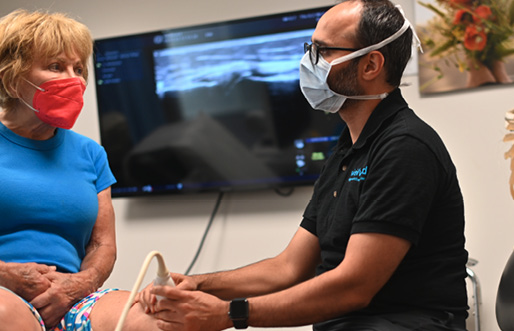At Wellward Regenerative Medicine, it’s a journey from joint degradation to healing.

LEXINGTON Most people over 40 live with some degree of joint pain, and the average physically active adult may consider arthritic joints an inevitable price of maintaining an active lifestyle. This may be endurable; anti-inflammatory drugs and analgesics get many of us through the next pick-up game or run. But an acute injury, such as a meniscal tear, sidelines these cherished activities. At Wellward Regenerative Medicine, Danesh Mazloomdoost, MD, and staff help patients understand the connection between the chronic arthritic state and the traumatic injury, and how to recover from the latter by attending to the former. By giving them the why of knee pain, Mazloomdoost helps patients avoid the next disrupting meniscal tear. Armed with an understanding of how to holistically heal and then maintain their joints, the Wellward patient can ensure that healing outpaces degradation and they can continue to enjoy an active lifestyle.
Mazloomdoost has two tenets that he imparts to joint pain sufferers that he believes help them refocus their efforts. Foremost, he employs a musical metaphor: “There is a concert of movement around each joint,” he explains. “Each participating tissue needs to be properly tuned to produce the most enduring piece of music.” Furthermore, arthritis occurs when that concert of movement is not happening the way it should. Such a joint is vulnerable to traumatic injury from something as simple as stepping oddly. As such, all the different components of knee usage should be addressed for enduring healing.
His second tenet is that inflammation is the mechanism of repair. Close attention to the sites of inflammation and the measured masking of it with anti-inflammatories are key to determining where the maladaptive motions—the out of tune instruments—have occurred. Mazloomdoost leads his patients to consider how to prepare for knee joint usage: “I want a knee user to know what they can do in the big picture to get the best longevity of that joint. Degradation is inevitable, but so is repair. The key is getting the repair to outpace the degradation,” he says.
A Common Diagnosis.
A New Prescription.
Consider the middle-aged jogger who has long relied on a morning endorphin rush and gross motor reset but might be carrying a little extra weight and feels some knee stiffness most days. Eventually a small ache on the inside of the knee is regularly felt at the end of jog. Heading into work one day, a minor slip like stepping off a curb happens, and now it is difficult to go up stairs. With a visit to the doctor, a medial meniscus tear is revealed. For Mazloomdoost, there is a causal chain here: the preexisting compromised knee was vulnerable to this low level “catastrophic event.”
After a medial meniscus tear is diagnosed through ultrasound or MRI, there are several common options with reliable outcomes. Many people choose rest and eventual healing, but Mazloomdoost says this works only about 30% of the time. A meniscectomy has long been the preferred surgical procedure, followed by physical therapy. Over the years, however, higher rates of osteoarthritis down the line have been correlated. Mazloomdoost and Wellward Regenerative have a vision for a more successful and enduring course of healing, however. Their approach integrates multiple variables for diagnosis and a holistic approach to reestablishing joint health. Mazloomdoost says his course of treatment consistently results in good outcomes for his patients.
First Follow the Pain, Then Attend to the Lifestyle
Mazloomdoost starts by following the pain. For him it is the canary in the coal mine that will clarify the maladaptations in and around the joint. His focus is on understanding the biomechanics of joint pain. “I want to use a patient’s symptoms to understand what components might be failing and then reverse engineer that.” His diagnostic tools include a biomechanical assessment, diagnostic ultrasounds, and MRI. This is followed by an acute workup. He tactically alleviates pain with injections of local anesthetic that both numb and add volume to temporarily inflate ligaments or specific components to see where the pain originates. After this acute workup, he employs a generalized lifestyle evaluation to examine all the elements that contributed to this pain, so that there is longevity in the healing process.
For Mazloomdoost, osteo-arthritis is a preventable disease once the biomechanics have been understood. To remain active, his patients must be committed to addressing how the joint is being used, or misused. Minor joint pain must be understood as the indicator for adjusting behaviors. “Almost everyone has that small achiness. If we marginalize it, ignore it, and say, ‘I’ll just take some anti-inflammatories,’” Mazloomdoost says, “we are missing opportunities to reduce degradation.” Overuse of anti-inflammatories can obscure other indicators; these suppress the mechanism of repair. “The better approach,” he says, “is to use the pain to figure out how we restore that normal function.” He has a useful analogy: “If the alignment on our car is off, we can still drive it. The tires will start to wear unevenly as a result. The uneven wear requires tire replacement sooner than necessary.” In similar fashion, taking care of joint alignment can spare a future joint replacement.
The Biodynamics of Meniscus Tear—and Healing It
Our jogger’s medial meniscal tear may have manifested suddenly, but Wellward approaches it as a result of pre-existing instability. Central to this is a stressed coronary ligament, whose function is to stabilize the menisci and limit rotation of the knee, which causes the other connective tissues of the knee to be misused. This puts an unnatural torsional stress on the knee due to uncoordinated movement. The knee is primed for that tear because it has been weakened at many points.
There are several ways to begin the healing process. “To strengthen that coronary ligament and alleviate strain on the meniscus, we use the connective tissues to stabilize and strengthen the area,” Mazloomdoost explains. Focused exercising of the muscles, tendons, and ligaments that work together with some degrees of redundancy takes pressure off the coronary ligament. An additional approach could include the mortar and pestle effect that standard physical therapy provides: grinding down the tear to clean it up. There are also regenerative strategies such as injecting platelet rich plasma (PRP) or stem cell derived therapies directly into the tear that will accelerate the recovery.
Hopefully a patient leaving Wellward’s care knows how to prevent the problem thereafter and reduce the potential for arthritis. Wellward can cure the disease and inform their patients about how to guard the health, but it is up to each patient to do it. They will know the exercises that are ideal for their body. Our jogger may need to incorporate other types of tissue strengthening exercises. They will know the nutritional needs and the supplementing process, such as timing collagen and vitamin C supplements to aid with tissue repair prior to exercise. They will know their options for taping or bracing for the external stabilization that may be needed temporarily until structures are fully strengthened. They will know how to both reduce degradation and increase healing.
According to Mazloomdoost, the Wellward truisms for joint care are simple:
- Joint degradation is inevitable.
- Pain tells us what to heal.
- There are multiple tools for healing.
- If healing outpaces degradation, we may avoid traumatic injury.
He concludes, “We are taking a holistic perspective to joint injury that results in preventive management of arthritis.” Patients leave Wellward with homework and a list of warning signs to watch for, and with the knowledge that can keep the pace of joint repair ahead of the pace of joint degradation.



